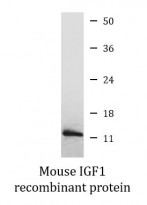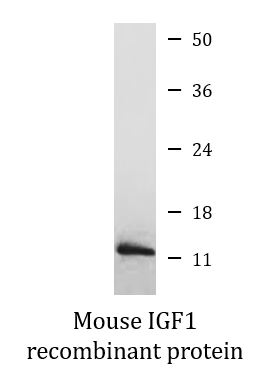Mouse IGF1 recombinant protein (Active) (His-tagged, C-ter)
CAT.NO. : ARG70190
US$ Please choose
US$ Please choose
概述
| 产品描述 | E. coli expressed, His-tagged (C-ter) Active Mouse IGF1 recombinant protein |
|---|---|
| 应用 | SDS-PAGE |
| 靶点名称 | IGF1 |
| 物种 | Mouse |
| A.A. 序列 | Gly49 - Ala118 |
| 表达系统 | E. coli |
| 生物活性 | Active |
| 活性说明 | Determined by its ability to induce MCF-7 cells proliferation. The ED50 for this effect is5 x 10^5 IU/mg. |
| 別名 | MGF; Insulin-like growth factor I; Mechano growth factor; Somatomedin-C; IGFI; IGF-I |
属性
| 形式 | Powder |
|---|---|
| 纯化说明 | Endotoxin level is less than 0.1 EU/µg of the protein, as determined by the LAL test. |
| 纯度 | >98% (by SDS-PAGE) |
| 缓冲液 | PBS (pH 8.0) |
| 复溶 | It is recommended to reconstitute the lyophilized protein in sterile water to a concentration not less than 200 μg/mL and incubate the stock solution for at least 20 min at room temperature to make sure the protein is dissolved completely. |
| 存放说明 | For long term, lyophilized protein should be stored at -20°C or -80°C. After reconstitution, aliquot and store at -20°C or -80°C for up to one month. Storage in frost free freezers is not recommended. Avoid repeated freeze/thaw cycles. Suggest spin the vial prior to opening. |
| 注意事项 | For laboratory research only, not for drug, diagnostic or other use. |
生物信息
| 基因名称 | IGF1 |
|---|---|
| 全名 | insulin-like growth factor 1 (somatomedin C) |
| 背景介绍 | The protein encoded by this gene is similar to insulin in function and structure and is a member of a family of proteins involved in mediating growth and development. The encoded protein is processed from a precursor, bound by a specific receptor, and secreted. Defects in this gene are a cause of insulin-like growth factor I deficiency. Alternative splicing results in multiple transcript variants encoding different isoforms that may undergo similar processing to generate mature protein. [provided by RefSeq, Sep 2015] |
| 生物功能 | The insulin-like growth factors, isolated from plasma, are structurally and functionally related to insulin but have a much higher growth-promoting activity. May be a physiological regulator of [1-14C]-2-deoxy-D-glucose (2DG) transport and glycogen synthesis in osteoblasts. Stimulates glucose transport in rat bone-derived osteoblastic (PyMS) cells and is effective at much lower concentrations than insulin, not only regarding glycogen and DNA synthesis but also with regard to enhancing glucose uptake. May play a role in synapse maturation. [UniProt] |
| 细胞定位 | Secreted. [UniProt] |
 New Products
New Products





















